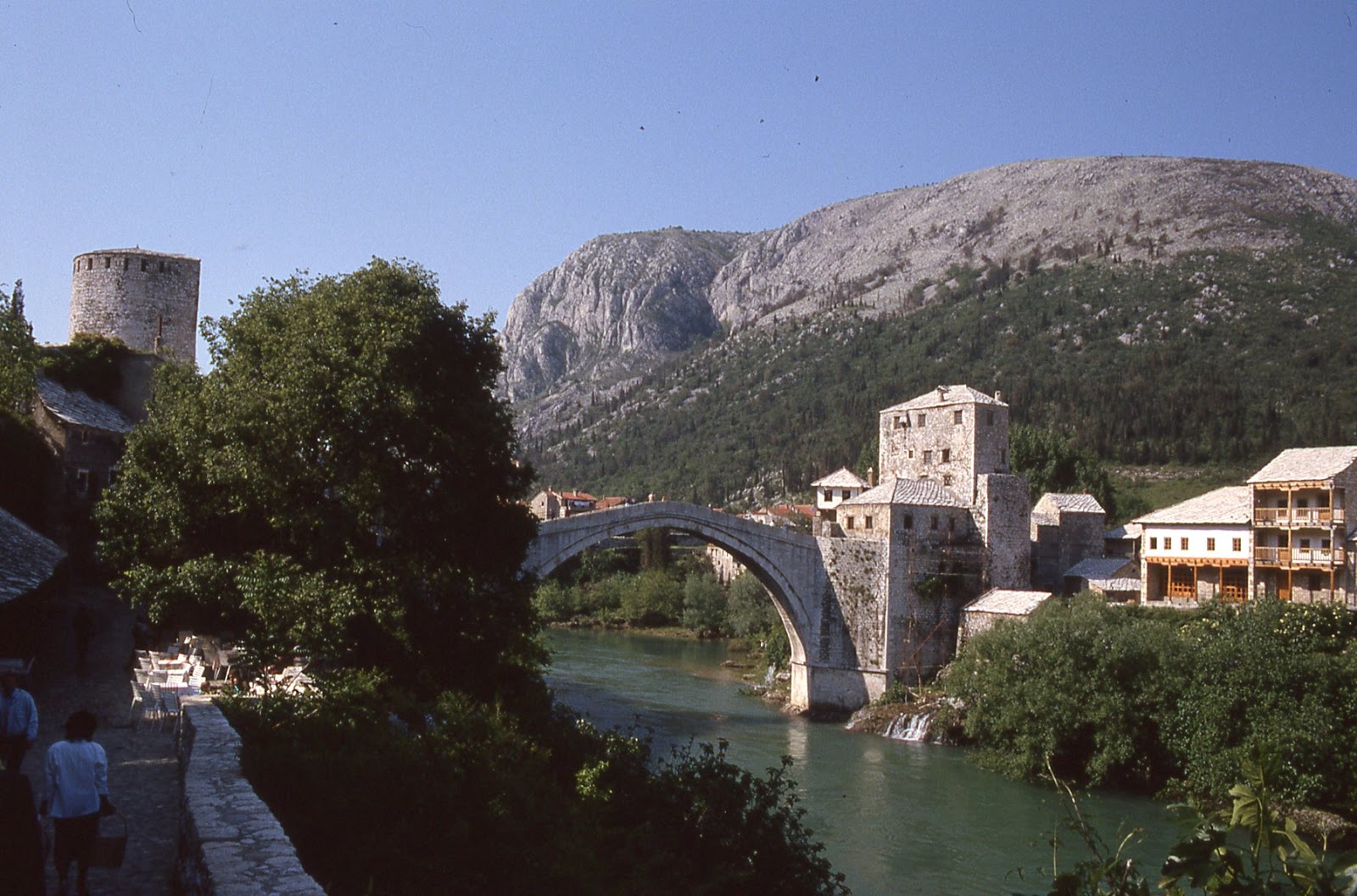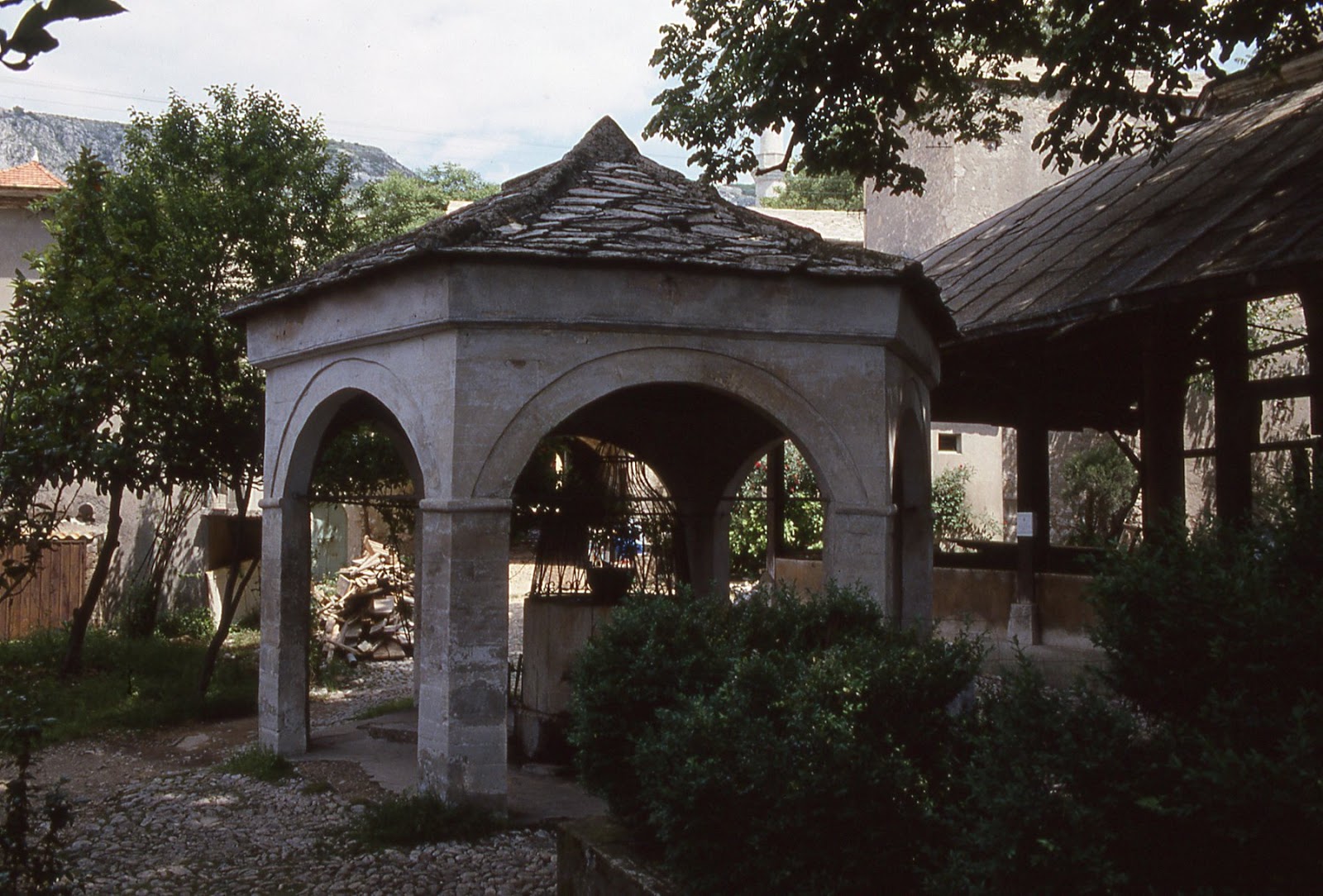
Previously: ON THE AVENUES: My Franz Ferdinand heritage trail, 30 years ago in Sarajevo.
Granted, my 1987 trip notes were sketchy and inconsistent, but they were even less coherent in Sarajevo and Mostar. Maybe I was enjoying myself too much to write (read: drinking too many cheap draft beers).
Day 33 … Monday, May 18
Sarajevo. “Mickey” $5.50 room, 170 dinar beer, affordable city
Day 34 … Tuesday, May 19
Sarajevo. Chair lift (Neil/Caren)
Day 35 … Wednesday, May 20
Sarajevo. Mosque, etc
Day 36 … Thursday, May 21
Sarajevo. Rain, shut in.
Day 37 … Friday, May 22
Mostar. Suitable 4,000 dinar room, decent weather
Day 38 … Saturday, May 23
Mostar. Good day, up to SOC, Mostar’s Moberly, sidewalk pivo, etc
A dollar bought around 500 dinar, which helps to make sense of the quoted prices. Beers at a pub were 40 cents, and even less if purchased in bottles at a shop. Meals were two or three bucks … and so on.
SOC surely means Serbian Orthodox Church (more on this in a moment), and “Moberly” refers to my high school pal Jeff, who used to play acoustic guitar and sing as we sat around the bonfire and drank beer. There was just such a performer playing for tips in Mostar as I drank at a sidewalk cafe overlooking the famous bridge, hence my note.
There is considerable melancholy attached to my recollections of what is now independent Bosnia Herzegovina, given the country didn’t exist in 1987, and was subsequently created only after the Yugoslavcivil war, a horrible conflagration that killed thousands.
The country then known as Yugoslavia always was intended to be a high point of the 1987 trip, and it definitely filled the bill. Just four years later, all of it went up in flames as I watched from America via television news. There hasn’t been a return trip to the region during the decades since, although we keep talking about beginning the cycle anew with a tour of Slovenia.
Of all the places I’ve been, none seem as surreal in retrospect as this corner of the Balkans.
Roger, seeing as you were in Yugoslavia in 1987, only four years before the tragic and murderous civil war began, can you tell us all about the rampant warning signs you noticed?
Actually, no, I can’t. I was entirely oblivious.
It should have told me something important about Yugoslavia that in the 1980s, Rebecca West’s Black Lamb and Grey Falcon, still was considered essential pre-trip reading. West’s book, a survey of travel and history in the region, was published in 1941.
In fact, I did read it, and came away from the 1,000+ pages with an image of the Balkans as not dissimilar from Appalachian stereotypes about the Hatfields and McCoys. Between West’s book and my university studies, I arrived in Yugoslavia with a passing knowledge of the country’s history as a tacked-together Great War creation, a jumble of multi-syllabic Balkan peoples, religions and languages cast together into a “Kingdom of South Slavs.”
At conception, Yugoslavia suffered from a feudal Ottoman legacy of impoverishment, turbulence and suffering. Nowhere in Europe were urban residents and rural dwellers so far apart. History simply had not dealt these people a very good hand.
However, by the 1980s an entirely new narrative had emerged. In it, the non-aligned socialist government controlling Yugoslavia following the viciousness of World War II had admirably succeeded in molding a cosmopolitan “Yugoslav” identity, as opposed to separate ethnicities and faiths.
 |
| Tito in Sarajevo. |
Marshall Tito (Josip Broz) was the hero of moment credited with had put an end to the bickering, and in many respects he genuinely had, partly through an instinctive understanding of the human terrain in a difficult neighborhood (the Balkans), partly through an aptitude for judicially rendered totalitarian methodology, and partly through the common Communist trick of keeping ordinary people so relentlessly busy in pursuit of the tiniest details of reasonable life that they were too tired to rebel.
But, yes, Tito kept things together for so long as his heart was beating. When it stopped, in 1980, the genies began creeping from their prison bottles. Those few short years later, when the country went up in smoke, and an unbelievable stream of abuses and horrors unseen since World War II took a crumbling Yugoslavia back to medieval times, I asked myself the question dozens of times: What happened to make these seemingly ordinary people leave their homes and go berserk?
On the other, apart from the stock hellos, goodbyes and how much, I came utterly without communication skills … and, apart from people like Radojko Petkovski of Skopje and a handful of other natives closer to my own age, Yugoslavia in 1987 was not the exact a patch of Europe where one could find great numbers of English speakers.
Consequently, although it was always possible to get by, and sometimes even deeper insights could be gleaned, conversations of greater depth with natives were seldom possible. I met other tourists, but when one communicates with another tourist, especially an English speaker, there is a natural tendency toward self-fulfilling prophecies, and to reinforce what already is known, rather than to ask questions and learn the score … and most of us had read from the same elementary tour guide playbook.
There are hundreds of answers, but the point to me is that when I was there, the question wasn’t being asked, and if it was, I didn’t hear it.
Shame on me.
—
The psychological highlight of Sarajevo was the chance to commune with the ghost of Franz Ferdinand, but my room was so cheap and Mickey such a genial host that I stuck around for two more aimless days of wandering, drinking local beer while reading the official vacation novel, Tolstoy’s War and Peace, and plopping myself atop benches to watch urban life roll past.
I vaguely remember Neil and Caren, who were from Minnesota. They were following traces of their Jewish heritage; we became acquainted while riding a streetcar, and I joined them for their explorations. We had a meal far out in the suburbs, drank beer, and eventually found the chairlift. The recollections end there. Wherever the two of you are, I hope you’re well.
I was headed for the coast on Friday, and Mostar was the next stop, three hours by train from Sarajevo. It was during this ride that Yugoslavia’s mountains became a tangible, visceral presence.

One of my memories of this trip was a long period when the train stopped and sat, apparently waiting for another train coming in our direction to pass over a stretch of single track. Here’s the view from my window.

I was in the compartment nearest the toilet, which in the typical European fashion of the time usually involved a foot pedal and trap door which deposited one’s leavings onto the track.
However, some Yugoslav trains didn’t have a commode, just a hole in the floor. Mine was one of them. It remains difficult for me to imagine squatting on a moving train, and perhaps this is why, with yet another contingent of soldiers on the train, as we sat stock still atop the high mountain pass for an hour, they marched one by one to the WC, and …
I was very glad when the train started moving again.

As with Sarajevo, my room in Mostar was in a private home. It was roomier and slightly more expensive. The lure of Mostar was the city’s multicultural reputation and its Stari Most, or old bridge.
Mostar is situated on the Neretva River and is the fifth-largest city in the country. Mostar was named after the bridge keepers (mostari) who in the medieval times guarded the Stari Most (Old Bridge) over the Neretva. The Old Bridge, built by the Ottomans in the 16th century, is one of Bosnia and Herzegovina’s most recognizable landmarks, and is considered one of the most exemplary pieces of Islamic architecture in the Balkans.
As many readers already know, and as referenced in a previous installment, the bridge was destroyed during fighting in Mostar (1992-94) and later rebuilt. For more information on crimes against Yugoslavia’s cultural and religious heritage committed during the civil war, visit Targeting History and Memory.


There were stray intact bits of the old Ottoman central district.


The market area.


The Serbian Orthodox Church (preceding and below; officially, known as the Cathedral of the Holy Trinity) was positioned on the hillside overlooking the heart of Mostar.

This Orthodox church was completely destroyed during the fighting, and its reconstruction finally was coming close to conclusion as of last year.
Travel writer Rick Steves offers this observation in a piece about Mostar, which looks as though it was written in 2007.
Now the bridge has been rebuilt and Mostar is thriving. It happens to be prom night. The kids are out, and Bosnian hormones are bursting. Being young and sexy is a great equalizer. With a beer, loud music, desirability, twinkling stars — and no war — your country’s GDP doesn’t really matter.
And yet, strolling through teeming streets, it’s chilling to think that, just a few years ago, these people — who make me a sandwich, direct me to a computer terminal in the Internet café, stop for me when I cross the street, show off their paintings, and direct the church choir — were killing each other.
I know the feeling, although in reverse — a few years after, not before.
Since Steves wrote, Mostar continues creeping up lists of must-see destinations. Cheryl Howard’s 2014 account brings you up to date with text and wonderful photos.
I admit that Mostar took me by surprise. There is so much more to Mostar than the Old Bridge. From hiking through the nearby forested mountains, to taking in holy sites, posing with weird and offbeat statues, walking through medieval towns, swimming under waterfalls, exploring abandoned ruins and hunting down street art, I couldn’t help but wonder time and time again, why Mostar is not on more peoples’ travel radars.
I’d love to go back.











